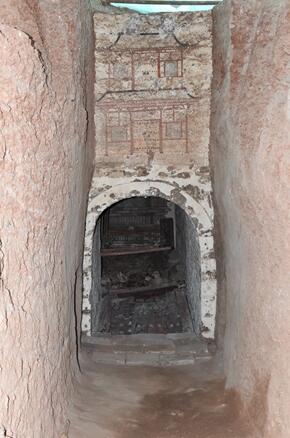Four new ancient Silk Road archaeological sites discovered in China
Two thousand years ago, people in Northwest China helped build the Silk Road, which allowed them to trade with far-off nations and live a prosperous life. Although some of these smaller villages and towns along the ancient trade route have gone unnoticed by the history books, recent archeological discoveries are providing us with valuable insight into the culture and economy of the time.
On Friday, China's National Cultural Heritage Administration (NCHA) announced four new archaeological sites in Northwest China's Xinjiang Uyghur Autonomous Region, Qinghai Province and Gansu Province that vividly reveal the prosperity and cultural exchanges that took place along the ancient Silk Road.

A turquoise gold cup discovered in a tomb in Ulan county, Northwest China's Qinghai Province Photo: Courtesy of China's National Cultural Heritage Administration
The first site is a tomb in Chashan village, Gansu Province. The site possesses one of the best preserved tombs of a royal family in Tuyuhun, a neighboring kingdom located in the upper Yellow River valley during the early and middle Tang Dynasty (618-907). The archaeological team has unearthed a large number of relics at the site including gold- and silverware, leather and silk fabric as well as painted pottery, fully demonstrating the funeral system of the Tuyuhun royal family.
"The excavation of the tomb has important research value for the study of the late Tuyuhun burial customs, the history of the relations between the Tang Dynasty and Tuyuhun and the history of the ancient Silk Road," the NCHA said in a statement.
Two other tombs were discovered in Qinghai Province in the counties of Dulan and Ulan.
The Dulan tomb is the most exquisite and complex burial site ever discovered on the Qinghai-Tibet Plateau. A horse pit found in the tomb has provided important information for studying the funeral system and religious concepts of the people living on the Qinghai-Tibet Plateau at that time. Many of the unearthed relics and the decorative patterns on them originated from the Sasanian Empire, the last kingdom of the Persian Empire in west Asia, and Sogdia, an ancient Iranian civilization in Central Asia, which shows that Dulan was an important node along the Silk Road that played an important role in cultural exchanges between the East and West.

A tomb in Chashan village, Northwest China's Gansu Province Photo: Courtesy of China's National Cultural Heritage Administration
In the dark space of the Ulan tomb, a well-preserved gold crown and a turquoise gold cup were discovered, providing clues for understanding the empire's administrative and military establishment in the area. Experts speculate that the tomb owner was a member of the royal family of the Tibetan Empire from the 7th to 9th centuries,
The tombs also possessed rare and beautifully painted murals whose content shows characteristics of the nomadic nations of the Qinghai-Tibet Plateau. They are of great value for researching Han-Tibetan cultural integration and exchanges between various ethnic groups along the Silk Road.
The fourth site is a military smoke signal site in Yuli county, Xinjiang Uyghur Autonomous Region, dating from the Tang Dynasty (618-907). The team unearthed many texts related to the military, politics, economy and literature of the time in the tomb, filling gaps in the historic records of the military and town defense system of the Tang Dynasty and proving the effective governance of the dynasty over the various local ethnic groups.
"The archaeological achievement in Xinjiang Uyghur Autonomous Region is the epitome of the identity of the central government and Chinese culture among the various ethnic groups in China's western regions," Li Wenying, deputy director of the Institute of Cultural Relics and Archaeology in the Xinjiang Uyghur Autonomous Region, told the Global Times on Sunday.
"The ethnic frontier areas, especially the Xinjiang Uyghur Autonomous Region, were the hub of the ancient Silk Road. The archeological discoveries in the area is of great significance for studying the effective governance and jurisdiction of the frontier regions by the Tang Dynasty as well as the formation of Chinese civilization," Li noted.
"The ethnic groups along the Silk Road participated in the cultural exchanges along the road and played their respective roles in the road's ethnic and cultural diversity. The archaeological work in these ethnic areas help us understand the culture and history of ancient people and their role in the formation of the Chinese nation," Chen Leng, a professor at Peking University's School of Archaelogy and Museology, told the Global Times on Sunday.

